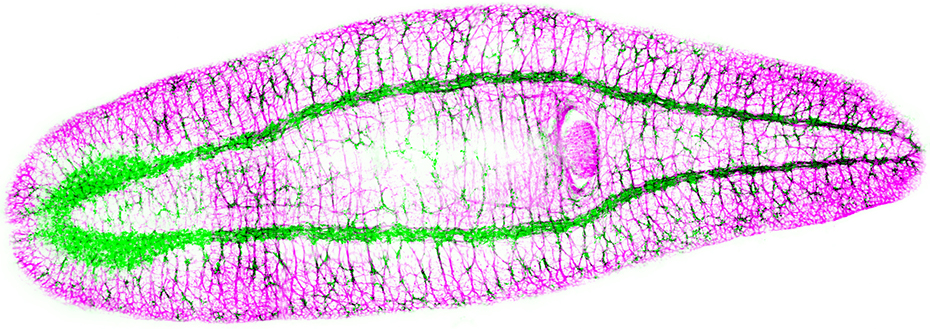Pearson Lab

Basic research interests
We use the freshwater planarian (Schmidtea mediterranea) and zebrafish (Danio rerio) as model organisms to study how adult stem cells make their precise cellular lineages during neural regeneration following acute injury. We also study how this biology becomes dysregulated during the formation of brain cancers such as glioblastoma multiforme.
Our overarching goal is to understand the basic biology and molecular mechanisms of neural regeneration at a single-cell level.
Ongoing research projects
Unlike most organisms, planarians can be decapitated and regenerate a new pair of eyes, a brain, and functionally reintegrate new tissue with old in approximately 7 days. In addition, they have unlimited capacity to perform this regenerative task and do so without scaring. We have several big questions we are investigating as to how this amazing biology works:
- Do planarians have neural stem cells?
- Do planarians use homologs of key transcription factors used in embryonic neural development in other model systems to accomplish neural regeneration?
- How do new neurons find their synaptic partners in old tissue to restore function?
Do planarians have neural stem cells?
To tackle this question, we have turned to single-cell RNA sequencing (scRNAseq). We have found that there exists a type of stem cell in planarians that has neural character by scRNAseq (below). We are now working on identifying the transcription factors that specify the neural-biased stem cell.
Do planarians use homologs of key transcription factors to accomplish neural regeneration?
We have performed RNAi screens on over 200 transcription factors to identify ones that direct the specification or patterning of neural subtypes. We have uncovered many interesting factors, but importantly, there appears to be two major pathways for a new neuron to integrate into the brain. Either a cell is going to be ventral medial or dorsal lateral. We have found that a tcf homolog, tcf-1, specifies new neurons to a dorsal lateral fate while arx and nkx2 homologs specify neurons to ventral medial fates. We are now combining RNAi phenotypes with the scRNAseq data to computationally predict routes of differentiation, which we then test in vivo.
We are now combining RNAi phenotypes with the scRNAseq data to computationally predict routes of differentiation, which we then test in vivo.
How do new neurons find their synaptic partners in the old tissue?
Little is known about this biology in planarians, so we are performing RNAi screens of candidate molecules. In addition, this question can be addressed in the zebrafish model of spinal cord regeneration. Stay tuned to what we find out!
Conservation of pluripotency
Pluripotency is a rare property of stem cells whereby they have the potential to make any differentiated cell types in the organism. Fortunately, planarian adult stem cells have this property. We hypothesized that because mammalian embryonic stem cells and planarian adult stem cells have the biology of pluripotency, they may also share common genetic programs. We took the following comparative genomic approach to show that this is indeed the case.
We purified planarian stem cells by FACS and deep sequenced the cells. We also deep sequenced whole, irradiated planarians that no longer have any stem cells. After comparing these tissue compartments, we found that 2,177 transcripts are specifically expressed in planarian stem cells.
After mapping planarian homologs to mammalian genes, we used mouse Gene Ontology (GO) terms to determine whether there was an enrichment of a particular cellular process in any given tissue compartment. Importantly, we found that planarian stem cells are enriched for the p53 and Retinoblastoma pathways over differentiated tissues, which supported our previous work. This gave us confidence that mouse GO terms can be used for planarian gene homologs, at least to some extent.
We compared genes that were enriched in planarian stem cells to both mouse and human embryonic stem cells. For this analysis, we only used genes that had a 1:1 match between planarians and mammals. To our surprise, we found 123 genes that are highly expressed in the pluripotent stem cells of each species.
Principal Investigator
Bret Pearson, Ph.D.
Professor of Pediatrics
pearsobr@ohsu.edu